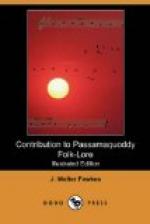One of the most interesting of the selections mentioned is the Song of the Snake Dance, No. 8. Although the ceremonial element has now disappeared from this song, it may be presumed that it originally had a religious importance similar to that of the Snake Dances of the Southwest, since the extent of the worship of the snake among North American Indians is known. The same dance is also celebrated by the Micmacs, having been performed by them during the past year. In both nations, it is generally united with other dances, and seems to be an appendage to the more formal ones.
The general impression among the Passamaquoddies is that this dance never had a sacred character. The name is said to have been derived from the sinuous course of the chain of dancers, and from its resemblance to the motion of a snake. While there is nothing to prove that it is a remnant of an ancient snake worship, still it is natural to presume that such is really the case. There are several tales relating to the manner in which men were turned into rattlesnakes, and how the noise of the rattlesnakes has its lineal descendant in the rattles of the dancers. The Indians told me of several songs used for snake dances, but in those which were sung I think I detected the same music, and am confident that the words as given occur in most of them. The discord at the end of the first line is also a feature of the snake dances which I have heard.[5]
[Footnote 5: I myself have never witnessed the snake-dance. The description which follows was obtained from Mrs. Brown, who has seen it performed twice, as well as from Peter Selmore, Noel Josephs, and other Indians who have frequently taken part in it. The song was recorded on the phonograph from the lips of Josephs, who is recognized by the Indians themselves as one competent to sing the song. Josephs told me that he remembered when this and other dances took place in a large wigwam made of bark.]
The dance is performed at weddings and other festive occasions. It is not used alone, but only with others, and, as I am told, is employed at all times of festival.
SNAKE SONG.
The words of the first strain are as follows:—
W[)a]y’ ho y[=a]rhnie, way ho y[=a]rhnie.
The words of the second strain are as follows:—
Hew nay ie h[=a]h, hew n[)a]’y
ie h[=a]h, hew n[)a]’y ie h[=a]h,
Hew nay ie h[=a]h, hew nay
ie h[=a]h, hew nay ie h[=a]h.
When the strain changes from the first to the second, the words ho yar’h nie become a discord like noy[=a]h.
The first part of the song is sung alone, by the conjurer, as he moves about the room in search of the snake. In the second part all in the chain of dancers join in with him in the song. The description of the song in Passamaquoddy, including the invitation to take part in the dance, is given on the first part of the cylinder. Calls to the assembly to join in the dance are interpolated in the second strain.




